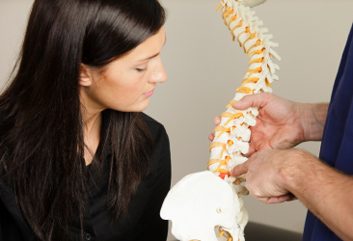
The shape of your spine
Are you sitting up straight right now, or hunched over your keyboard, trying to ignore that nagging pain in your back? If you fall into the latter category, you’re not alone-over 85 percent of the population will experience back pain at some point in their lives, according to the CBI Health Group.
In the days of girdles and corsets, slouching was nearly impossible. But these days, it’s far more common, says Esther Gokhale, a California-based acupuncturist and author of 8 Steps to a Pain-Free Back. “Old posture was cast as rigid and passé, while slouching became more fashionable,” she explains. “It is unnatural, but we have come to celebrate it.” Gokhale notes that whether we realize it or not, our posture is sending a non-verbal message to the rest of the world, every day-and it’s not necessarily a good one.
Here’s what the shape of your spine says about you, and what you can do to improve your posture.

C, S or J: What shape are you?
Gokhale identifies three main spinal shapes: the C-spine, which makes you appear slouched; the S-spine, which creates an exaggerated sense of “standing up straight,” and the J-spine, which is a more neutral position. The J-spine is what we should be working towards, says Gokhale. The term J-spine refers to a state in which the spine takes on a gentle, natural curvature, allowing us to stand upright but still feel relaxed. “It is truly natural,” says Gokhale, who notes that children and people in pre-industrialized cultures are the best examples of this shape.
“When we are born, we basically have a c-curve in the spine,” explains Natalia Lishchyna, vice president of the Ontario Chiropractic Association. “As we age, we get an s-curve-a curve in the neck and a lumbar curve. We want those natural curves to be supported.”

What causes bad posture?
“Bad posture is happening increasingly early because of our poor baby furniture, and then poor sitting habits in schools,” says Gokhale. “As children, we sit so many hours a day, we become rigid. And that carries over into adulthood.”
Lishchyna notes that posture can also change depending on your age, environment and lifestyle. “You see kids carrying heavy backpacks, or adults walking around with a heavy computer case over one shoulder,” she says. “Unfortunately, people don’t always notice that their posture is incorrect. Over time, it can lead to a lot of problems.”

What does your spine say about you?
“Good posture reflects on your self-esteem,” says Lishchyna. “You appear more confident, and it allows you to make a better first impression.” Bad posture, on the other hand, can have the opposite effect. “We wear a posture of depression,” says Gokhale. “When we slouch, our spine takes on a C-shape, which communicates depression and submission.”
However, our attempts to “stand up straight” and correct slouching may also be damaging, says Gokhale. “When you try to correct that C-spine, you can end up over-compensating and creating an S-spine, which can cause muscle tension and pain,” she says. “It conveys a message of false confidence, of trying to please.”
“The J-spine is the natural shape for our species,” says Gokhale. “It conveys a quiet authority, natural grace and dignity.”

How to improve your posture
The first step to better posture can be as simple as recognizing the environment you’re in, says Lishchyna. “When people come into my clinic, they are already at the pain stage,” she says. “We want them to recognize the signs before the pain happens.”
So what can you do to improve your posture and alleviate pain? “First, be aware of your posture,” she says. “If you’re sitting at a computer, ask yourself: Are your feet touching the ground? Are your arms at 90-degrees? Be aware of your environment.” If you find that you experience pain throughout the day from sitting, try taking frequent breaks, or doing some stretches. If you continue to experience back pain, Lishchyna recommends that you seek professional treatment.

Just think tall!
You can also practice what Gokhale refers to as “stretchsitting” and “stretchlaying.” And above all, “Think tall,” she says. “Reframe your everyday acts, such as bending an walking, as exercise. As your posture improves, your energy will increase, your confidence will increase, and you will be able to enjoy improved mental health.”
Related:
• A new way to stretch out back pain
• 3 moves to strengthen your back
• The benefits of AntiGravity Yoga
